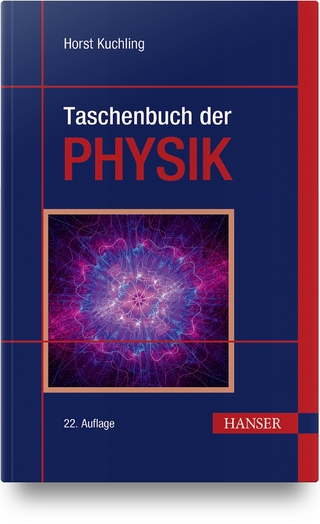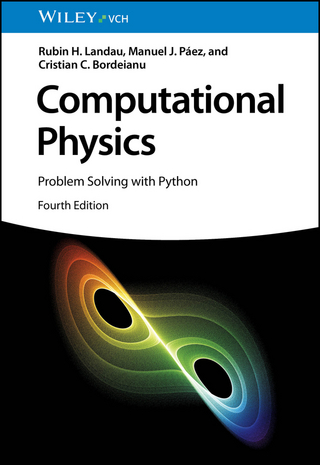
Wafer Manufacturing
John Wiley & Sons Inc (Verlag)
978-0-470-06121-3 (ISBN)
Presenting all the major stages in wafer manufacturing, from crystals to prime wafers.
This book first outlines the physics, associated metrology, process modelling and quality requirements and the goes on to discuss wafer forming and wafer surface preparation techniques. The whole is rounded off with a chapter on the research and future challenges in wafer manufacturing.
Imin Kao, is Professor in the Department of Mechanical Engineering at the State University of New York in Stony Brook, USA. He is Faculty Director of the Undergraduate College in Information and Technology Studies. He holds three patents, and his research foci include robotic manipulation with soft contacts and smart contact surface technology using MEMS. Chunhui Chung, is Associate Professor in the Department of Mechanical Engineering at the National Cheng Kung University in Taiwan.
Preface xi
Acknowledgement xiii
Part I From Crystal to Prime Wafers 1
1 Wafers and Semiconductors 3
1.1 Introduction 3
1.2 Semiconductor Revolution 3
1.2.1 Classification of Materials 3
1.2.2 Semiconductor Revolution Today 5
1.2.3 SiliconWafers and Solar Cells 6
1.3 SiliconWafers Used in Device Manufacturing (IC and MEMS) 7
1.3.1 StandardWafer Diameters and Sizes 8
1.3.2 Crystalline Orientation of SiliconWafers 9
1.3.3 Moore’s Law 11
1.4 Surface Properties and Quality Measurements ofWafers 11
1.4.1 SurfaceWaviness: TTV, Bow, andWarp 11
1.4.2 Discussion onWarp 16
1.4.3 Automated Measurements of TTV,Warp, Bow, and Flatness 17
1.4.4 Wafer Flatness 17
1.4.5 Nanotopography or Nanotopology 21
1.4.6 Surface Roughness 22
1.5 Other Properties and Quality Requirements of SiliconWafers 27
1.5.1 Mechanical and Material Properties 27
1.5.2 Property of Silicon with Anisotropy 27
1.5.3 Gravity-induced Deflection ofWafers 30
1.5.4 Wafer Edge Properties 31
1.6 Economics ofWafer Manufacturing 32
1.6.1 Three Categories ofWafers 32
1.6.2 Cost of SiliconWafers 34
1.7 Summary 35
References 35
2 Wafer Manufacturing: Generalized Processes and Flow 39
2.1 Introduction 39
2.2 Wafer Manufacturing: Generalized Process Flow 39
2.3 Crystal Growth 41
2.3.1 Melt Growth 41
2.3.2 Vapor Growth 49
2.3.3 Epitaxial Growth 49
2.3.4 Casting Polycrystalline Crystal 51
2.3.5 Other Crystal Growth Methods 51
2.4 Wafer Forming 52
2.4.1 Cropping 52
2.4.2 Trimming 52
2.4.3 Orientation Identification 52
2.4.4 Slicing 52
2.4.5 Slicing Using the Inner-diameter (ID) Saw 53
2.4.6 Slicing Using a Wiresaw 54
2.4.7 Other Tools for Slicing 55
2.4.8 Edge Rounding 56
2.5 Wafer Polishing 56
2.5.1 Lapping 57
2.5.2 Grinding 57
2.5.3 Etching 58
2.5.4 Polishing 58
2.6 Wafer Preparation 58
2.6.1 Cleaning 58
2.6.2 Inspection 59
2.6.3 Packaging 59
2.7 Industrial Processes ofWafer Manufacturing 59
2.7.1 Crystal Growth 60
2.7.2 Wafer Forming 61
2.7.3 Wafer Lapping and Polishing 63
2.7.4 Wafer Preparation 66
2.8 Summary 67
References 68
3 Process Modeling and Manufacturing Processes 71
3.1 Introduction 71
3.2 Wafer Manufacturing and Brittle Materials 71
3.3 Ductile Machining Versus Brittle Machining 73
3.4 Abrasive Machining inWafer Manufacturing 74
3.4.1 Bonded Abrasive Machining (BAM) 75
3.4.2 Free Abrasive Machining (FAM) 75
3.5 Abrasive Materials 76
3.5.1 Classification of the Grain Size of Abrasive Materials 77
3.5.2 Hardness of Abrasive Materials 78
3.5.3 Commonly Used Abrasive Materials inWafer Manufacturing 81
3.6 Ductile Machining of Brittle Materials 82
3.6.1 Research on Ductile Machining and Challenges 83
3.6.2 Opportunity and Future Research 83
3.7 Process Modeling ofWafer Manufacturing Processes 84
3.7.1 Rolling-indenting and Scratching-indenting Process Models of FAM 84
3.7.2 Comparison Between Wiresawing and Lapping 87
3.7.3 Other Aspects of Engineering Modeling 88
3.8 Abrasive Slurry in FAM Processes 89
3.8.1 Composition of Abrasive Slurry 89
3.8.2 Comparison ofWater and Glycol as a Carrier Fluid for Slurry 90
3.8.3 Recycling of Abrasive Grits in Slurry 91
3.9 Summary 93
References 93
Part II Wafer Forming 97
4 Wafer Slicing Using a Modern Slurry Wiresaw and Other Saws 99
4.1 Introduction 99
4.2 The Modern Wiresaw Technology 100
4.2.1 Historical Perspectives of Saws UsingWire 100
4.2.2 The Rise of the PV Industry andWafer Slicing 102
4.3 The Three Categories of Saw forWafer Slicing 103
4.4 Inner-diameter (ID) Saw 103
4.5 The Modern Slurry Wiresaw 105
4.5.1 The Control and Program Console 106
4.5.2 The Wire Management Unit 106
4.5.3 Uni-directional Versus Bi-directional Wire Motion 110
4.5.4 The Slicing Compartment 113
4.5.5 Directions of Ingot Feeding 114
4.5.6 Consumables and Other Operations 116
4.6 Comparison Between the ID Saw and Wiresaw 116
4.7 Research Issues inWiresaw Manufacturing Processes 120
4.8 Summary 121
References 121
5 Modeling of the Wiresaw Manufacturing Process and Material Characteristics 127
5.1 Introduction 127
5.2 The Rolling-indenting Model 129
5.3 Vibration Modeling and Analysis 131
5.3.1 A Historical Perspective on the Vibration ofWire 132
5.3.2 Equation of Motion of a Moving Wire 133
5.3.3 Modal Analysis of an Undamped Moving Wire 134
5.3.4 Response for Point-wise Harmonic Excitation 134
5.3.5 Natural Frequency of Vibration and Stability 135
5.3.6 Numerical Solution Using Galerkin’s Method 138
5.3.7 Response of Multiple-point and Distributed Excitations 139
5.3.8 Frequency Response of Multiple Excitations 141
5.3.9 Vibration Responses of a Moving Wire with Damping 143
5.3.10 Discussions 144
5.4 Damping Factor of the Slurry Wiresaw Systems 145
5.5 Elasto-hydrodynamic Process Modeling 147
5.5.1 Approach of Modeling of EHD in the Wiresawing Process 148
5.5.2 Theoretical Modeling 149
5.5.3 Results of the EHD Analysis 150
5.5.4 Implications Related to Floating Machining and Rolling-indenting Modeling of Modern Slurry Wiresaws 152
5.5.5 Important Conclusions from EHD Modeling 155
5.6 Thermal Management 156
5.7 Wire, WireWeb, and Slurry Management 156
5.7.1 Real-time and On-line Monitoring of WireWear 157
5.7.2 Monitoring the Pitch of the WireWeb Spacing 160
5.7.3 Mixing Ratio of Slurry Consisting of Abrasive Grits and Carrier Fluid 162
5.8 Summary 162
References 163
6 Diamond-Impregnated Wire Saws and the Sawing Process 169
6.1 Introduction 169
6.2 Manufacturing Processes of Diamond-impregnated Wires 171
6.2.1 Resinoid Wires 172
6.2.2 Electroplated Wires 174
6.2.3 Machines and Operations of Diamond Wire Saws 175
6.3 Slicing Mechanism of a Diamond Wire Saw 177
6.4 Properties ofWafers Sliced by Diamond Wire Saws 180
6.4.1 Wafer Surface 180
6.4.2 Wafer Fracture Strength 181
6.4.3 Residual Stress and Stress Relaxation 182
6.4.4 PVWafer Efficiency 182
6.4.5 Cost ofWafering 182
6.5 Slicing Performance with Different Process Parameters 183
6.5.1 Effect of Wire Speed 183
6.5.2 Effect of Feed Rate 183
6.5.3 Effect of Grain Density 184
6.5.4 Effect of Wire Tension 184
6.6 Summary 184
References 185
Part III Wafer Surface Preparation and Management 189
7 Lapping 191
7.1 Introduction 191
7.2 Fundamentals of Lapping and FAM 192
7.3 Various Configurations and Types of Lapping Operation 195
7.3.1 Single-sided Lapping 200
7.3.2 Double-sided Lapping 201
7.3.3 Soft-pad Lapping 201
7.3.4 Further References 202
7.4 Lapping and Preliminary Planarization 202
7.4.1 Quality Driven Needs for Preliminary Planarization 202
7.4.2 Cost Driven Needs for Preliminary Planarization 203
7.5 Technical Challenges and Advances in Lapping 204
7.5.1 Technical Considerations 205
7.5.2 Advances in Lapping 206
7.6 Summary 206
References 207
8 Chemical Mechanical Polishing 209
8.1 Introduction 209
8.2 Chemical Mechanical Polishing (CMP) 210
8.2.1 Schematic Illustration of the CMP Process and System 210
8.2.2 Measurement and Evaluation of the SiliconWafer after Polishing 213
8.2.3 Specifications for Polished SiliconWafers 214
8.2.4 Types of CMP Processes 215
8.2.5 Challenges of CMP Technology 215
8.3 Polishing Pad Technology 215
8.3.1 Polishing Pad Conditioning 216
8.4 Polishing Slurry Technology 217
8.5 Edge Polishing 218
8.5.1 Fundamentals of Edge Polishing 218
8.5.2 Challenges of Edge Polishing 218
8.6 Summary 219
References 219
9 Grinding, Edge Grinding, Etching, and Surface Cleaning 223
9.1 Introduction 223
9.2 Wafer Grinding for Surface Processing 223
9.2.1 Wafer Grinding Methods 223
9.2.2 Grinding Wheel Technology 226
9.2.3 Types of Grinding Operations 227
9.2.4 Technical Challenges and Advances in Grinding 228
9.3 Edge Grinding 228
9.3.1 Fundamentals of Edge Grinding 229
9.3.2 Technical Challenges in Edge Grinding 231
9.4 Etching 231
9.4.1 Acid Etching 232
9.4.2 Caustic Etching 232
9.4.3 Preferential Etching 232
9.4.4 Technical Challenges and Advances in Etching 235
9.5 Surface Cleaning 236
9.5.1 Impurities on the Surface of a SiliconWafer 236
9.5.2 Various Cleaning Steps inWafer Process Flow 237
9.6 RCA Standard Clean 238
9.6.1 Introduction 238
9.6.2 RCA Cleaning Protocol 239
9.6.3 Techniques and Variations of the RCA Method 240
9.6.4 The Evolution of SiliconWafer Cleaning Technology 241
9.7 Summary 241
References 242
10 Wafer Metrology and Optical Techniques 247
10.1 Introduction 247
10.2 Evaluation and Inspection of theWafer Surface 247
10.2.1 Wafer Surface Specifications 247
10.3 Wafer Defects and Inspection 251
10.3.1 Defect Classification 251
10.3.2 Impact ofWafer Defects on Device Yield and Performance 253
10.3.3 Defect Inspection Techniques and Systems 254
10.4 Measurement of theWafer Surface Using Moiré Optical Metrology 256
10.4.1 Measurement of theWafer Surface Using Shadow Moiré with the Talbot Effect 257
10.4.2 Enhancing the Resolution of Shadow Moiré with “Phase Shifting” 262
10.4.3 WireWeb Management Using Optical Metrology Technology 273
10.5 Summary 274
References 274
11 Conclusion 279
11.1 (I) From Crystal to PrimeWafers 279
11.2 (II) Wafer Forming 280
11.3 (III) Wafer Surface Preparation and Management 281
11.4 Final Remarks 282
Index 283
| Erscheint lt. Verlag | 29.3.2021 |
|---|---|
| Verlagsort | New York |
| Sprache | englisch |
| Maße | 168 x 244 mm |
| Gewicht | 680 g |
| Themenwelt | Naturwissenschaften ► Physik / Astronomie |
| Technik ► Elektrotechnik / Energietechnik | |
| Technik ► Maschinenbau | |
| ISBN-10 | 0-470-06121-9 / 0470061219 |
| ISBN-13 | 978-0-470-06121-3 / 9780470061213 |
| Zustand | Neuware |
| Informationen gemäß Produktsicherheitsverordnung (GPSR) | |
| Haben Sie eine Frage zum Produkt? |
aus dem Bereich


